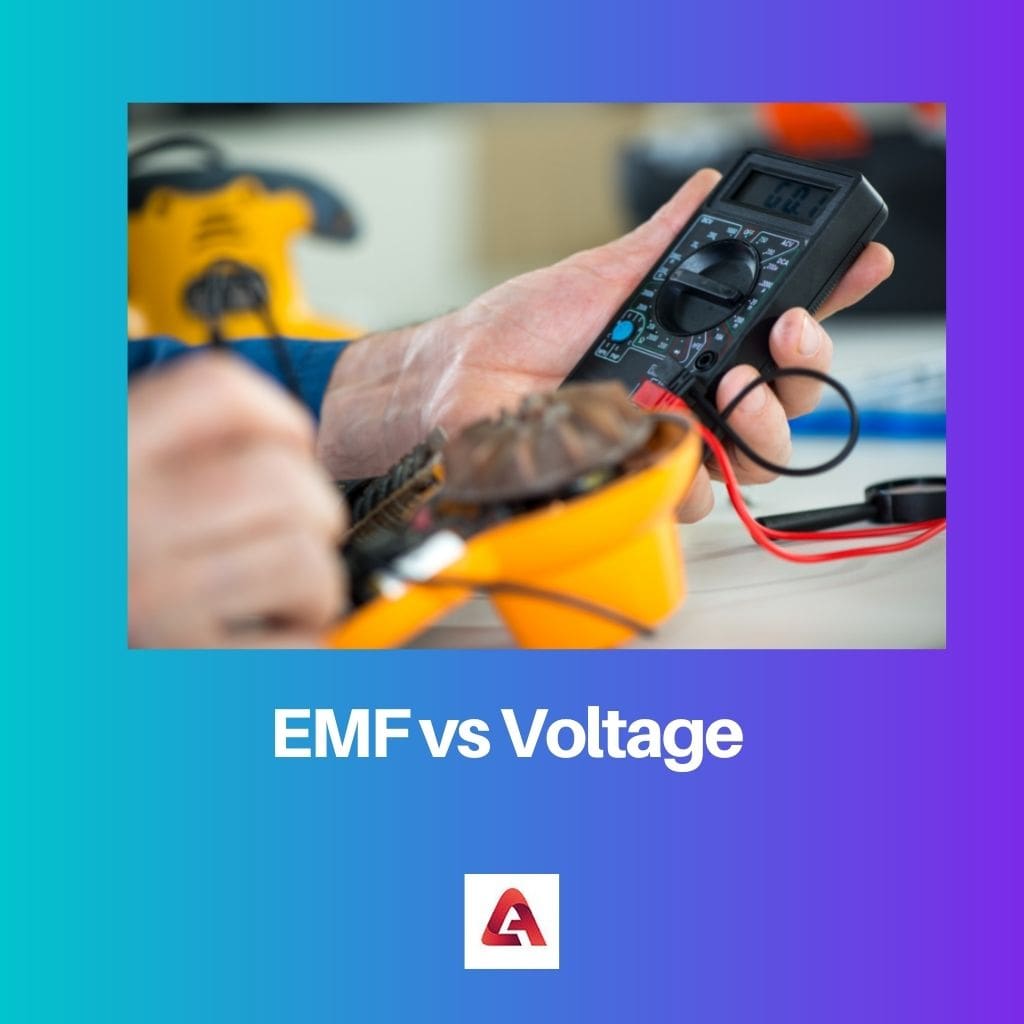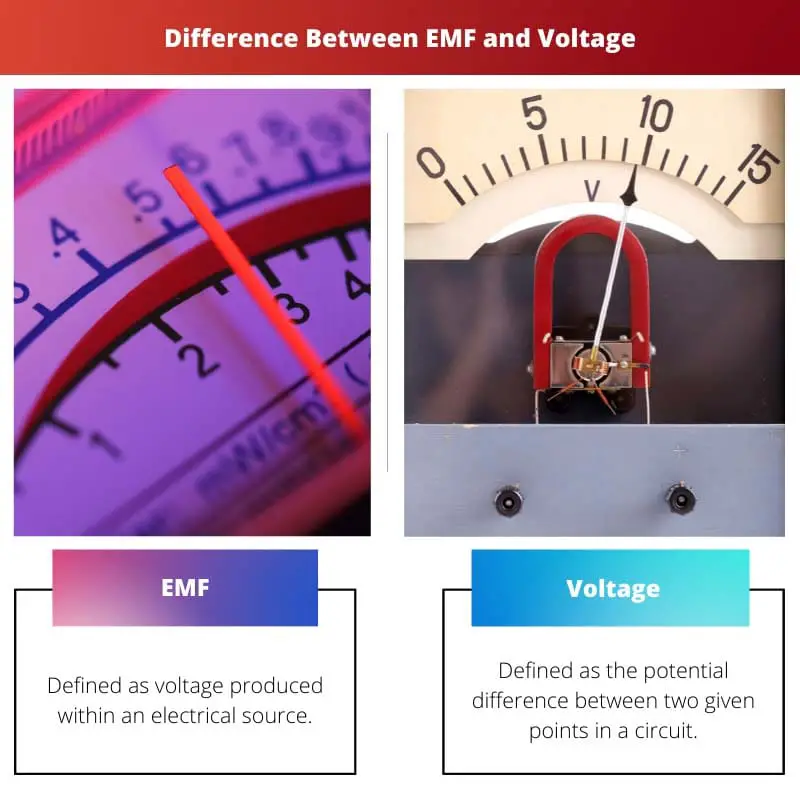EMF equals the potential difference between the two poles when no current flows through the circuit.
Voltage refers to the energy needed to transfer an electric charge from one end of the circuit to another, divided by the magnitude of the charge. Thus, although EMF and voltage are intrinsically linked, they are also significantly different.
Key Takeaways
- EMF stands for electromotive force and measures the potential energy that drives an electric current through a circuit; voltage measures the electric potential difference between two points in a circuit.
- EMF is the total energy that drives the current through a circuit, including the energy lost to internal resistance; voltage is the energy difference between two points in a circuit, excluding any internal resistance.
- EMF is measured in volts, as is voltage; however, EMF is the maximum voltage that can be generated by a source, while voltage is a measure of the energy present in a circuit at any given time.
EMF vs. Voltage
EMF is an electromotive force measuring the potential difference between two cell electrodes when the circuit is not connected or when the circuit is open. Voltage is the measure of potential energy required to move an electric current from one point to another in an electric field.

Comparison Table
| Parameters of Comparison | EMF | Voltage |
|---|---|---|
| Definition | Defined as voltage produced within an electrical source. | Defined as the potential difference between two given points in a circuit. |
| Formula | Ε =I (R+r) | V= I + R |
| Intensity | Constant intensity maintained | Intensity is not constant |
| Measuring Instrument | Measured with an EMF meter. | Measured with a Voltmeter. |
| Force operation | Coulomb force operation. | Non-Coulomb force operation. |
| Sources | Dynamo, electrochemical cells, solar cells. | Electric and magnetic fields. |
What is EMF?
EMF is short for Electromotive Force, defined as voltage produced within an electric cell. Energy is converted from one form to another in a generator or battery.
For this purpose, one terminal of the generator or battery becomes positively charged, and the other becomes negatively charged.
Work done per unit charge is denoted by EMF. EMF is the energy a cell or battery provides per unit of coulomb of charge that passes through it.
When no current flows through the circuit, EMF equals the potential difference between the two terminals. Volt is the unit of measuring EMF. The symbol of EMF is ε.
There are several alternative formulas to calculate EMF.
- ε = V + Ir
- V is used to connote the voltage of the cell.
- I am used to connoting the current flowing through the circuit.
- r is used to connote the internal resistance of the cell.
- And ε is used to connote EMF.
Another formula used to find out EMF is:
- ε = E/Q where,
- ε signifies EMF.
- E signifies energy in Joules.
- Q signifies charge in coulomb.
The formula can be altered considering the internal resistance of the cell. Then we derive another method for calculating EMF:
- Ε =I (R+r)
- ε signifies EMF
- I signify the current flowing through the circuit.
- R signifies the resistance offered by the circuit.
- R signifies the internal resistance of the cell.
What is Voltage?
Voltage is the amount of potential energy flowing between two points in a circuit. It is also defined as the potential energy available per unit charge.
Voltage is the pressure needed to push per unit electrical charge through a conducting loop in a circuit. It moves a unit charge from one point in the circuit to another.
The unit of measurement for voltage is the same as EMF. Named after the Italian scientist Alessandro Volta, both EMF and voltage share this unit of measurement.
Volta was credited to have discovered the first electronic battery.
Voltage is thus denoted in equations as ‘V.’ Voltage is a product of electric and magnetic fields.
Ohm’s law is used to calculate the voltage drop for each resistor. The common symbols for voltage include V, ∆V, U, ∆U.
The formula for calculating voltage:
V= I + R where,
- V connotes voltage.
- I connote the current flowing through the circuit.
- R connotes the resistance.
Main Differences Between EMF And Voltage
- The main difference between EMF and voltage is that the former represents the voltage inside each electrical source, while the latter represents the potential difference between two given points.
- The intensity of EMF is constantly maintained. The intensity of voltage charges can fluctuate. Thus, the voltage does not have constant intensity.
- The third difference between the two can be denoted in terms of the instrument of measurement used for each. EMF is measured using an EMF meter, while voltage is measured with a voltmeter.
- Sources of each also offer another point of difference. EMF sources include electric and magnetic fields producing dynamos, electromagnetic cells, solar cells, and voltage.
- Another notable difference between the EMF and voltage is force operation. EMF is a Coulomb force operation, while voltage is a Non-Coulomb force operation.
- While EMF can be measured between the two terminals when no current flows through the cell, the voltage can be measured between two points. This is a salient difference between EMF and voltage.
- Another interesting point of difference is their cause-effect relationship. EMF is the cause of voltage, and voltage is the by-product of EMF.




